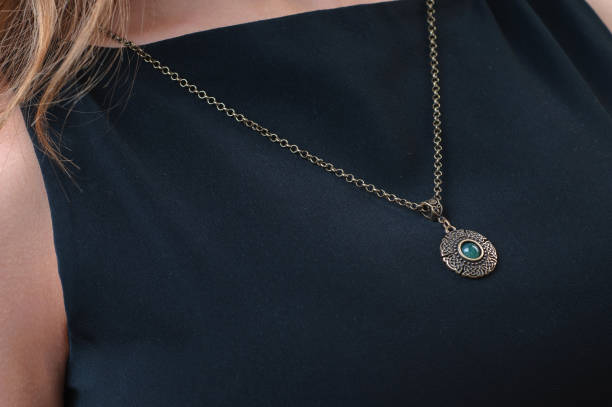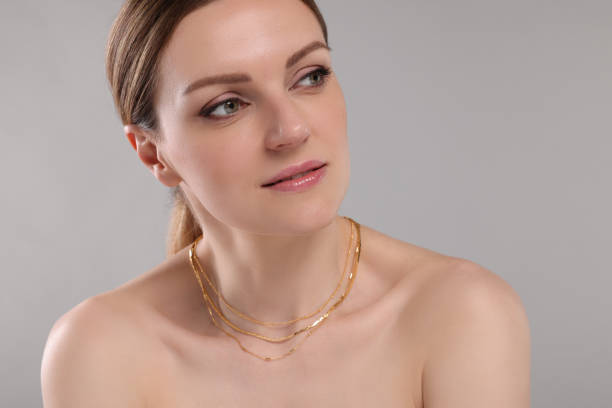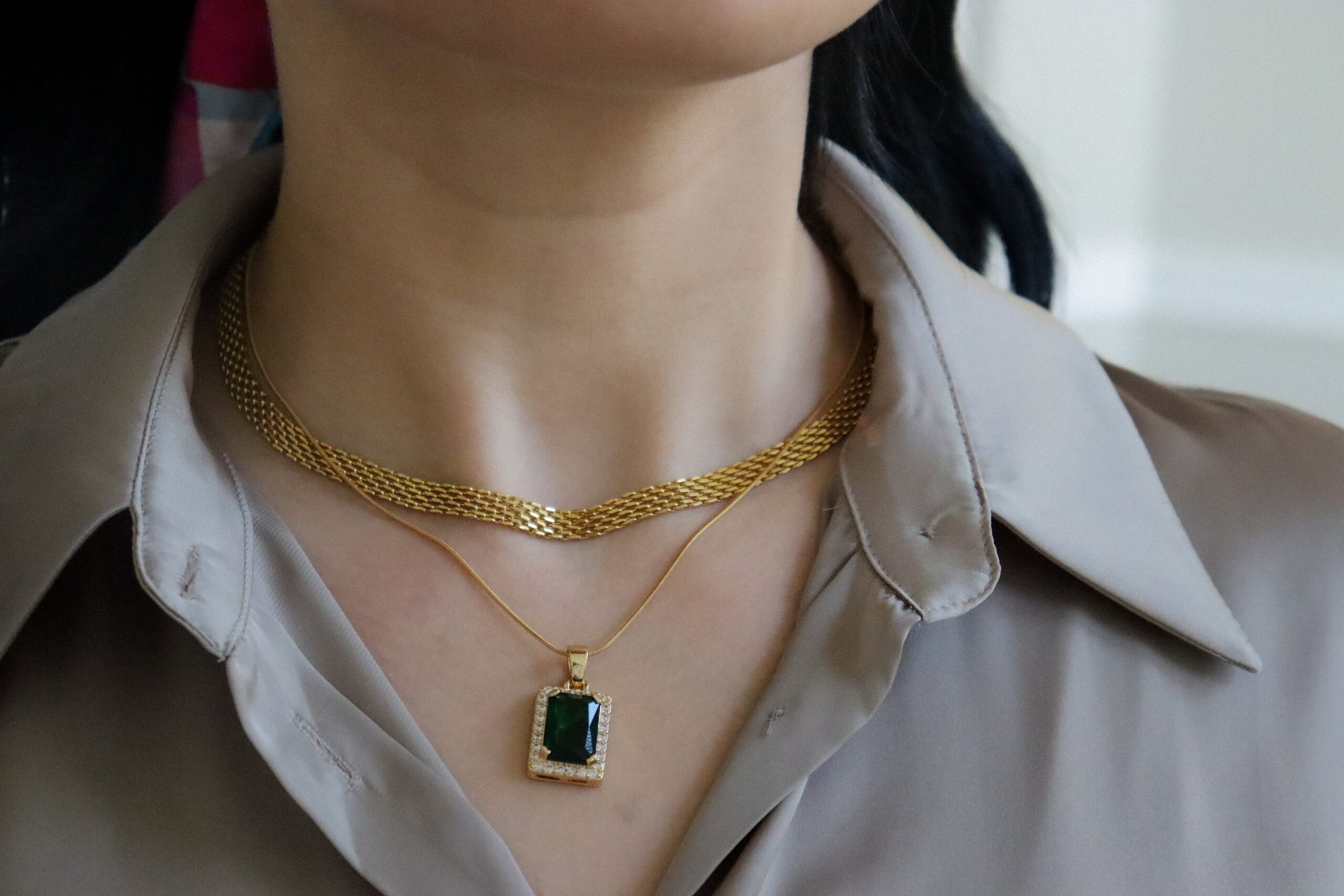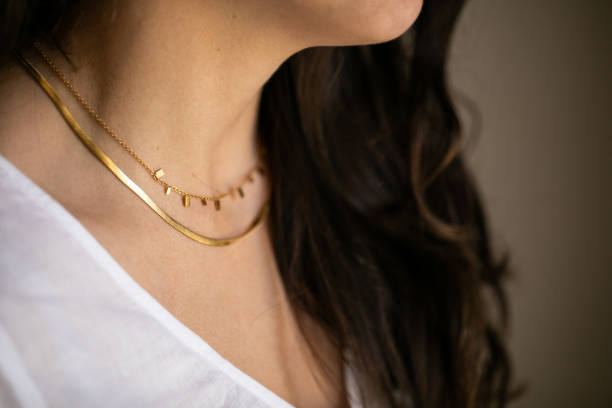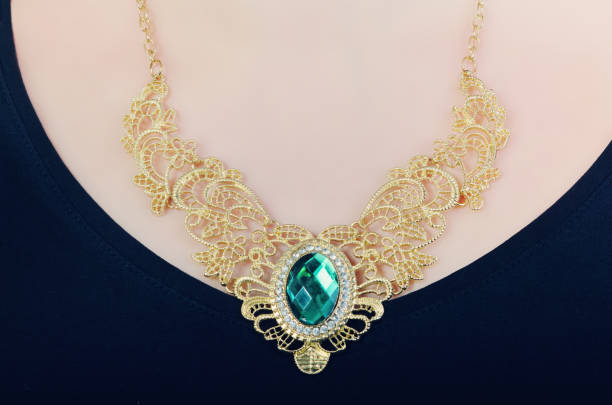
A way of ascertaining originality in a vintage 18-karat gold ornament.
Ever come across that old, apparently interesting jewelry box at the flea market and find in it some exquisite 18k gold necklace for women? You must have told yourself, “Is this genuine?” Vintage 18k gold necklace womens pieces do have this certain appeal that’s just hard to overlook, but identifying and authenticating it is about as slippery as a cat in a rocking chair-filled room.
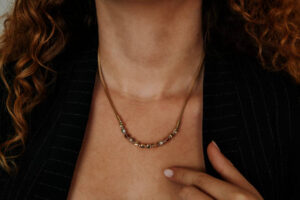
Look at the Stamps and Hallmarks
First, let’s concern ourselves with those small stamps and hallmarks. Take a good look with a magnifying glass. Any authentic 18k gold piece should have a hallmark indicating its gold content. Look for “18k” or “750.” These numbers are one and the same-75% pure gold. Yet again, bear in mind these marks can also be forged.
Weighted and Coloured: Feel the Gold
But of course, gold has just that specific color and heaviness to it. The real 18k would have this deep, warm yellow tone. It should not appear brassy or too shiny. If it is an 18k necklace, and if it feels just feather-light, then that is a warning. For since gold is dense, a heavy weight means a possibility of it being authentic.
Bite Test: Not Just Pirates
Ever hear of the bite test? Sounds like something out of a pirate movie, that’s old-school, effective. Real gold is soft, and when one bites down on it, he or she should be in a position to see an indentation. Just don’t chomp down too hard-we are authenticating jewelry here, not eating!
Magnet Test: The Easy Hack The following is a quick test you can do at home: the magnet test. Pure gold isn’t magnetic. Just hold a strong magnet over it and check to see whether your piece is drawn to it. If so, it is time to raise an eyebrow. This test isn’t the best, however, since not all of the metals combined with fake gold are magnetic, but it’s a good starting point.
Acid Testing Kits: The Amateur Detective Acid test kits will even allow you, the wannabe detective, to order online. Having some training will then enable you to take such a kit and determine the purity of gold yourself. A small scratch on the piece is exposed to various solutions of acid. By the reaction you can estimate how much gold is present in it. This is not devoid of risk, though-marks may stay on your jewelry.
Get Professional Help While the various methods of identification discussed here can get you pretty far, sometimes it’s simply worth having a professional take a look by a proper jeweler. A trained eye, using special equipment and techniques, lets you know for certain. The fee is usually quite minimal, especially if the piece happens to be of value.
Appreciate the artistry. The story which the vintage pieces can tell is in their craftsmanship. Look at the piece more closely: isn’t it done well with detailed work? Sometimes, the quality of work can give you some clues: the poor workmanship generally accompanies fake gold because, frankly, fraudsters are usually taking shortcuts.
Check for wear and tear:
You’d scratch for chafing: if the gold’s worn off and you see another metal beneath, you have a gold-plated creation. You can scratch a solid 18k piece of jewelry, but the color is homogenous all the way to the core.
How to Clean and Restore aan Old 18k Gold Necklace
An 18k gold chain is more than just an accessory on a woman’s neck.
It’s a timeless keepsake, an undue taste of class passed down the generations, carrying whispers of history. When it finally comes into your possession, it may perhaps be a tad worse for wear. Don’t bother getting it to the professional cleaners just yet. Much of that luster can be revived with a bit of elbow grease and a few handy tips.
First, allow me to discuss how to clean your favorite necklace at home. Mix a few drops of any mild dish soap into a small bowl of warm water-nothing too complicated, just soap and water. Place your necklace gently in the solution to soak for about 15 minutes while talking to your grandma about good times or watching some viral videos of cats. Soak it in the solution, then take a soft toothbrush-it might be small, like those kids use-and just scrub the necklace with it.
Nothing too heavy is required, just some circular motions lightly. Then, under lukewarm running water it goes, after which you pat it with a soft cloth until it dries. Voilà! You are halfway to restoring that look. Then there’s the remainder-the really obstinate stains that hang in there with your necklace, like that friend who has overstayed their welcome. Mix a small amount of baking soda into a light paste in case the mild soap does not work its magic. Sprinkle some baking soda in a bowl and add just enough water in it to make a paste. Gently smear this onto those unruly areas and massage with your fingers or that soft-bristled brush. In a little while, you’ll be able to make sure of those really raising the white flag.
Now, lemon juice and olive oil do sound like the beginnings of a great salad dressing, but hold onto those croutons. This combo will work in restoring brilliance to your necklace, too. Mix one part lemon juice with two parts olive oil; dip a cloth into the mix and lightly rub the necklace. Give it a good rinse afterward, and it’ll be bright as sunshine. These are great, but there are those moments when the necklace really needs a professional touch. You know, like the time you decided to fix that leaky tap and subsequently flooded the kitchen. Sometimes, guys, experts save the day.
Find a good local jeweler who will do the repair, particularly for the very delicate or intricate works. They will have the proper tooling for replacing clasps, reattaching links, and even reshaping parts that, during wear, have bent over time. Remember, storing your 18k gold necklace is pretty much the same as cleaning it. You wouldn’t just throw a priceless painting in the garage, right?
Get a jewelry box that has separate compartments, or you can put the necklace into soft-cloth pouches so it doesn’t scratch. Now, throw in that silica gel packet to absorb the moisture so that it doesn’t tarnish once again.
